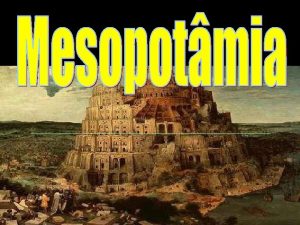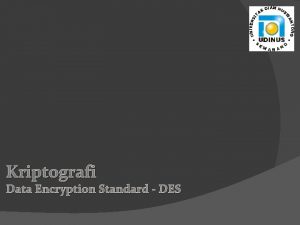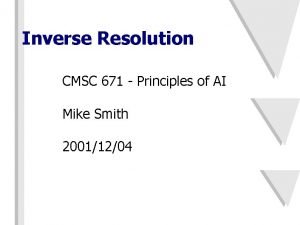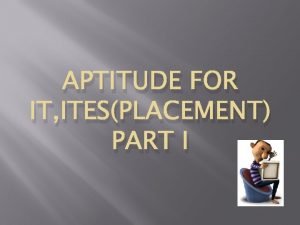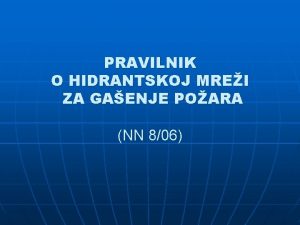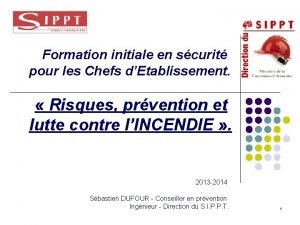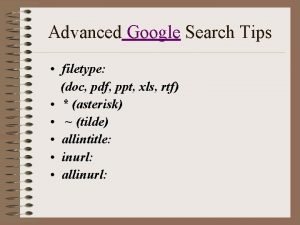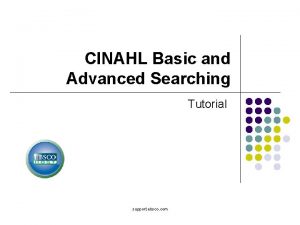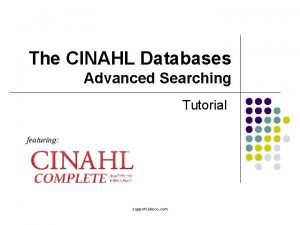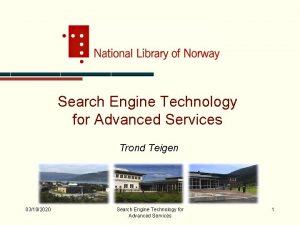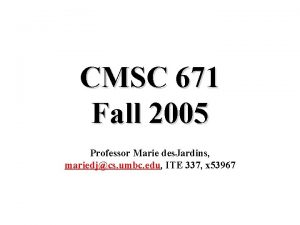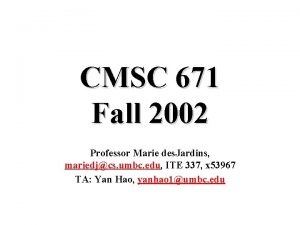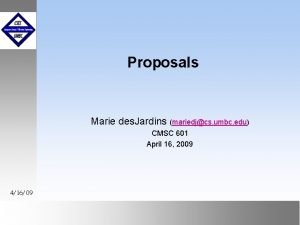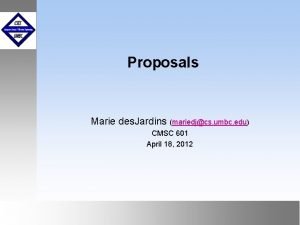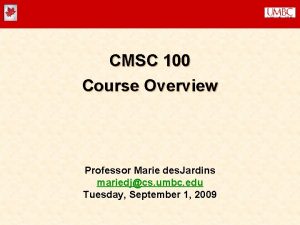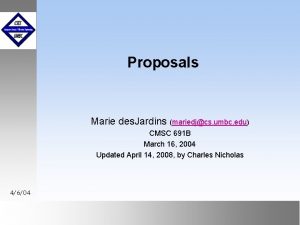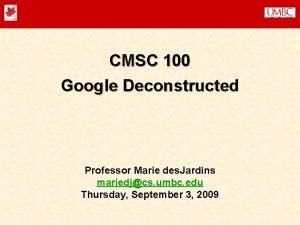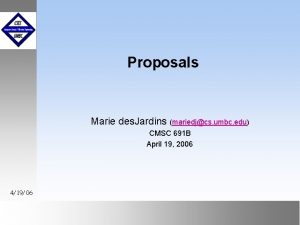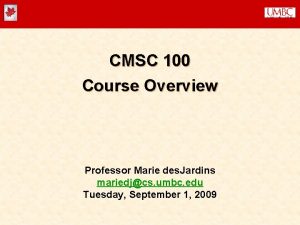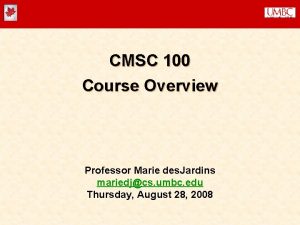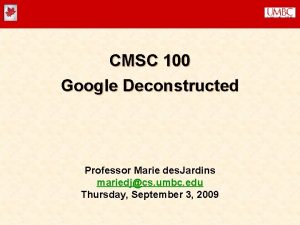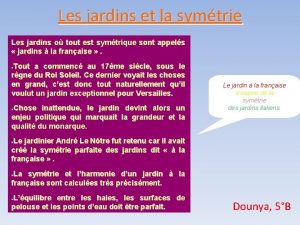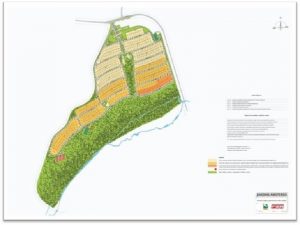CMSC 671 Advanced Search Prof Marie des Jardins

















- Slides: 17

CMSC 671 Advanced Search Prof. Marie des. Jardins September 20, 2010

Overview • Real-time heuristic search – Learning Real-Time A* (LRTA*) – Minimax Learning Real-Time A* (Min-Max LRTA*) • Genetic algorithms

REAL-TIME SEARCH

Real-Time Search • Interleave search and execution • Advantages: – Explore domain with unknown properties – Provide variable control over amount of search (deliberation) vs. execution (reactivity) – “Anytime” problem-solving performance – Interruptible – Learn to improve quality of heuristic function over multiple planning episodes – Can solve very large problems (if they have the right problem structure) Sven Koenig, “Real-time heuristic search: Research issues, ” In Proceedings of the AIPS-98 Workshop on Planning as Combinatorial Search: Propositional, Graph-Based, and Disjunctive Planning Methods, pages 75 -79, 1998.

LRTA* • Simplest version: one step lookahead with heuristic-value updating: 1. 2. 3. 4. 5. 6. 7. Initialize s to the start state If s is a goal state, stop Choose an action a that minimizes f(succ(s, a)) Update f(s) to the max of current f(s), 1+f(succ(s, a)) Execute action a Set s to the current state Go to step 2 Richard E. Korf, “Real-time heuristic search, ” Artificial Intelligence 42(2 -3): 189211, March 1990.

Search Example • What will each algorithm do? – – f(n): Greedy search (with and without repeated states) A* (with and without repeated states) Hill-climbing (One-step-lookahead) LRTA* 1 1 2 1 0 S A B C G 0 D

Min-Max LRTA* • Variation of LRTA* that can be used in nondeterministic domains 1. 2. 3. 4. 5. 6. 7. Initialize s to the start state If s is a goal state, stop Choose an action a whose worst possible outcome minimizes f(succ(s, a)) (minimax step) Update f(s) to the max of current f(s), 1+f(succ(s, a)) (across all possible successors of s when performing a) Execute action a Set s to the current state Go to step 2 Sven Koenig, “Minimax real-time heuristic search, ” Artificial Intelligence 129 (12): 165 -197, June 2001.

More Variations • Multi-step lookahead (using a “local search space”)

Incremental Heuristic Search • Reuse information gathered during A* to improve future searches • Variations: – Failure restart search at the point where the search failed – Failure update h-values and restart search – Failure update g-values and restart search • Fringe Saving A*, Adaptive A*, Lifelong Planning A*, DLite*. . .

GENETIC ALGORITHMS

Genetic Algorithms • Probabilistic search/optimization algorithm • Start with k random states (the initial population) • Generate new states by “mutating” a single state or “reproducing” (combining via crossover) two parent states • Selection mechanism based on children’s fitness values • Encoding used for the “genome” of an individual strongly affects the behavior of the search

GA: Genome Encoding • Each variable or attribute is typically encoded as an integer value – Number of values determines the granularity of encoding of continuous attributes • For problems with more complex relational structure: – Encode each aspect of the problem – Constrain mutation/crossover operators to only generate legal offspring

Selection Mechanisms • Proportionate selection: Each offspring should be represented in the new population proportionally to its fitness – Roulette wheel selection (stochastic sampling): Random sampling, with fitness-proportional probabilities – Deterministic sampling: Exact numbers of offspring (rounding up for most-fit individuals; rounding down for “losers”) • Tournament selection: Offspring compete against each other in a series of competitions – Particularly useful when fitness can’t be readily measured (e. g. , genetically evolving game-playing algorithms or Robo. Cup players)

GA: Crossover • Selecting parents: Pick pairs at random, or fitness-biased selection (e. g. , using a Boltzmann distribution) • One-point crossover (swap at same point in each parent) • Two-point crossover • Cut and splice (cut point could be different in the two parents) • Bitwise crossover (“uniform crossover”) • Many specialized crossover methods for specific problem types and representation choices

GA: Mutation • Bitwise (“single point”) mutation

GA: When to Stop? • • After a fixed number of generations When a certain fitness level is reached When fitness variability drops below a threshold. . .

GA: Parameters • Running a GA involves many parameters – – – Population size Crossover rate Mutation rate Number of generations Target fitness value. . .
 8merveille
8merveille Jardins suspensos da babilônia
Jardins suspensos da babilônia Des des des
Des des des Ai 671
Ai 671 Voicemail airtel
Voicemail airtel Find the odd one : 396, 462, 572, 427, 671, 264
Find the odd one : 396, 462, 572, 427, 671, 264 Hrn iso 6309
Hrn iso 6309 Nbn en 671-1
Nbn en 671-1 Tu es la plus belle des femmes marie souviens toi
Tu es la plus belle des femmes marie souviens toi Academic search google
Academic search google Google search for filetype
Google search for filetype Paul barron network reviews
Paul barron network reviews Advanced video search engine
Advanced video search engine Googlel calender
Googlel calender Epoline advanced search
Epoline advanced search Exiliker
Exiliker Cinahl advanced search
Cinahl advanced search Advanced image search engine
Advanced image search engine

